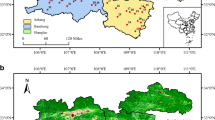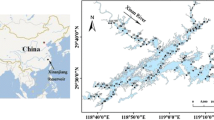Abstract
Over two hundred samples were collected in tropical headwater forested catchments in the lowland Amazon basin near Juruena, Mato Grosso Brazil. These were analyzed for fluorescence characteristics and DOC concentrations, and represented a range of terrestrial hydrologic flowpaths and first-order streams during baseflow and stormflow conditions. The fluorescence index (FI) of McKnight et al. (2001) was found to have a significant relationship with DOC concentrations for stream water at baseflow conditions, but FI values within individual terrestrial flowpaths and stormflow varied little for the range of DOC concentrations observed. FI values were seen to increase for increasing residence time of water within the terrestrial ecosystem, while DOC concentration decreased for increasing hydrologic residence time. The FI of terrestrial flow paths indicated that DOC became increasingly characterized by microbially derived carbon for flow paths with longer residence times, on the order through fall and overland flow < percolating soil water < groundwater. Base flow samples of stream water had a mean FI value of 1.78, compared with 1.51 and 1.44 for through fall and overland flow, respectively, and 1.65 for percolating soil water. The FI values for stream water at base flow were also seen to vary seasonally, and were inversely proportional to DOC concentrations over time.




Similar content being viewed by others
References
Balcarczyk KL, Jones JB, Jaffe R, Maie N (2009) Stream dissolved organic matter bioavailability and composition in watersheds underlain with discontinuous permafrost. Biogeochemistry 94(3):255–270
Brooks PD, Lemon MM (2007) Spatial variability in dissolved organic matter and inorganic nitrogen concentrations in a semiarid stream, San Pedro River, Arizona. J Geophys Res 112:G03S05. doi:10.1029/2006JG000262
Carstea EM, Baker A, Pavelescu G, Boomer I (2009) Continuous fluorescence assessment of organic matter variability on the Bournbrook River, Birmingham, UK. Hydrol Process 23(13):1937–1946
Cole JJ, Prairie YT, Caraco NF, McDowell WH, Tranvik LJ, Striegl RG, Duarte CM, Kortelainen P, Downing JA, Middelburg JJ, Melack J (2007) Plumbing the global carbon cycle: Integrating inland waters into the terrestrial carbon budget. Ecosystems 10(1):172–185
Cook RL, Birdwell JE, Lattao C, Lowry M (2009) A multi-method comparison of atchafalaya basin surface water organic matter samples. J Environ Qual 38(2):702–711
Cory RM, Miller MP, McKnight DM, Guerard JJ, Miller PL (2010) Effect of instrument-specific response on the analysis of fulvic acid fluorescence spectra. Limnol Oceanogr Method 8:67–78
Hood E, Fellman J, Edwards RT (2007) Salmon influences on dissolved organic matter in a coastal temperate brownwater stream: an application of fluorescence spectroscopy. Limnol Oceanogr 52(4):1580–1587
Jaffé R, Boyer JN, Lu X, Maie N, Yang C, Scully NM, Mock S (2004) Source characterization of dissolved organic matter in a subtropical mangrove-dominated estuary by fluorescence analysis. Mar Chem 84(3–4):195–210
Jaffé R, McKnight D, Maie N, Cory R, McDowell WH, Campbell JL (2008) Spatial and temporal variations in DOM composition in ecosystems: The importance of long-term monitoring of optical properties. J Geophys Res Biogeosci 113:G04032
Johnson MS, Lehmann J, Riha SJ, Novães Filho JP, Couto EG (2006a) DOC and DIC in flowpaths of Amazonian headwater catchments with hydrologically contrasting soils. Biogeochemistry 81:45–57
Johnson MS, Lehmann J, Selva EC, Abdo M, Riha SJ, Couto EG (2006b) Organic carbon fluxes within and exports from headwater catchments in the southern Amazon. Hydrol Process 20:2599–2614
Johnson MS, Weiler M, Couto EG, Riha SJ, Lehmann J (2007) Storm pulses of dissolved CO2 in a forested headwater Amazonian stream explored using hydrograph separation. Water Resour Res 43:W11201
Johnson MS, Lehmann J, Riha SJ, Krusche AV, Richey JE, Ometto JPHB, Couto EG (2008) CO2 efflux from Amazonian headwater streams represents a significant fate for deep soil respiration. Geophys Res Lett 35:L17401
Katsuyama M, Ohte N (2002) Determining the sources of stormflow from the fluorescence properties of dissolved organic carbon in a forested headwater catchment. J Hydrol 268:192–202
Mariot M, Dudal Y, Furian S, Sakamoto A, Vallès V, Fort M, Barbiero L (2007) Dissolved organic matter fluorescence as a water-flow tracer in the tropical wetland of Pantanal of Nhecolândia, Brazil. Sci Total Environ 388:184–193
Mayorga E, Aufdenkampe AK, Masiello CA, Krusche AV, Hedges JI, Quay PD, Richey JE (2005) Young organic matter as a source of carbon dioxide outgassing from Amazonian rivers. Nature 436:538–541
McKnight DM, Boyer EW, Westerhoff PK, Doran PT, Kulbe T, Andersen DT (2001) Spectrofluorometric characterization of dissolved organic matter for indication of precursor organic material and aromaticity. Limnol Oceanogr 46(1):38–48
Ohno T (2002) Fluorescence inner-filtering correction for determining the humification index of dissolved organic matter. Environ Sci Technol 36(4):742–746
Peel MC, Finlayson BL, McMahon TA (2007) Updated world map of the Köppen–Geiger climate classification. Hydrol Earth Syst Sci 11:1633–1644
R Development Core Team (2009) R: a language and environment for statistical computing. R Foundation for Statistical Computing, Vienna
Soil Survey Staff (1999) Soil taxonomy. USDA Natural resource conservation service, Washington
Westerhoff P, Chen W, Esparza M (2001) Fluorescence analysis of a standard fulvic acid and tertiary treated wastewater. J Environ Qual 30:2037–2046
Acknowledgments
The study was supported by NASA LBA-ECO grant to project group ND-11. The authors greatly appreciate the collaborations of field site hosts Rohden Indústria Lígnea Ltda. and Apolinário Stuhler. We thank Benedito Silveira de Andrade and Elielton Anterio da Souza for field assistance. Discussions with Robert G.M. Spencer and the comments provided by the anonymous reviewers were very useful in revising the manuscript.
Author information
Authors and Affiliations
Corresponding author
Rights and permissions
About this article
Cite this article
Johnson, M.S., Couto, E.G., Abdo, M. et al. Fluorescence index as an indicator of dissolved organic carbon quality in hydrologic flowpaths of forested tropical watersheds. Biogeochemistry 105, 149–157 (2011). https://doi.org/10.1007/s10533-011-9595-x
Received:
Accepted:
Published:
Issue Date:
DOI: https://doi.org/10.1007/s10533-011-9595-x




